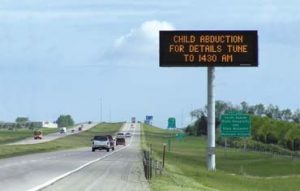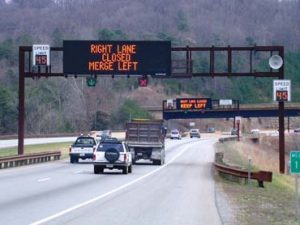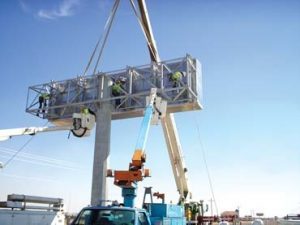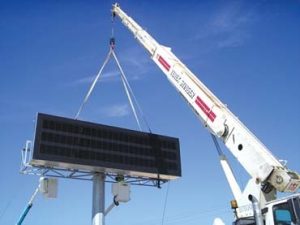Electric Signs
Instant Messaging on the Highway
Departments of Transportation turn to LED message centers to update travelers.
Published
18 years agoon
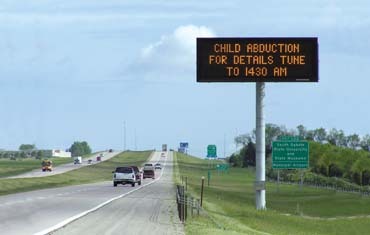
Highway streaming-text messages may not be entertaining, but they're crucial: "Accident ahead, reduce speed to 20 mph and use alternate Rte. 312 to avoid stalled traffic."
Many state Departments of Transportation (DOTs) have adopted LED message centers as their preferred highway-traffic management system to inform drivers about current travel conditions. Roadside, LED text messages instantly communicate ongoing, or unsafe, driving conditions and, if necessary, suggest alternate routes.
The sign systems report such roadside incidents as slowdowns, accidents, construction, lane closures, weather concerns, amber alerts and travel-time alerts. Alerts vary from global messages that cover the entire network (amber alerts and posted speed limits) to dedicated messages concerning road incidents along specific routes.
Highway LED electronic systems take many forms. Overhead electronic sign cabinets are suspended on scaffolds across highways. The walk-in sign cabinets allow onsite maintenance without interrupting traffic flow. Signs installed on single-post stanchions supply the same message capabilities as overhead highway signs on arterial, or secondary, roads, which feed traffic to and from major highways. The sign face lifts in sections to provide maintenance access to the interior.
To serve secondary roadsides, LED units can also be towed on mobile trailers to inform travelers about temporary road incidents, such as road construction. Toll-booth signage, which displays collection fees and lane directions, helps manage traffic-funnel locations near bridges and tunnel toll-collection points.
AdvertisementLED message centers have been integrated into highway-traffic management to form a complex, information-gathering network. The Intelligent Transportation System (ITS) program, the U.S. DOT's initiative to add information technology as a traffic-management component to each state's transportation infrastructure, helps improve safety and reduces vehicle wear, transportation time and fuel costs.
The U.S. DOT refers to ITS displays as "dynamic message signs" (DMS). State DOTs may describe them as "variable message signs" (VMS) or "changeable message signs" (CMS).
Sign manufacturers who work with DOTs must provide LED sign systems that communicate with the department's sign-network software program at its command center. The National Transportation Communications for Intelligent Transportation Systems (NTCIP) has issued protocols that define the systems' interoperability – the manner in which system components work together.
The NTCIP protocol establishes a traffic-control standard that allows DOTs to "mix and match" various types of LED sign equipment so they can operate in a common sign network, despite unique manufacturing or operating characteristics.
To understand the roadside-network environment, Georgia's and Washington's state DOTs have explained how they maintain and acquire electronic signage to manage traffic. Also, several LED sign manufacturers, who supply VMS signage to the state DOTs, have mapped out their VMS network.
AdvertisementGeorgia's CMS network
The Georgia DOT maintains one of the nation's oldest and most comprehensive ITS installations. Monica Luck, its public-relations spokesperson, said traffic significantly increased statewide in the late 1980s and early 1990s, and the 1996 Summer Olympics in Atlanta compounded the situation.
By turning to an electronic traffic-management system, the DOT quickly solved how overcrowded state and local roads could safely handle Olympic visitors, plus local residents, through the metro Atlanta area.
The ITS system included television monitors of highway traffic; onsite observers, who dealt with incident management and motorist assistance; ramp meters and weather monitoring.
The DOT's NaviGAtor website provided real-time local and regional, 24/7 traffic information. The LED message centers, which Georgia refers to as CMS, synthesized the information to alert drivers about travel incidents and, if they were serious, suggested alternate routes.
AdvertisementSince its Olympic success, Georgia has installed approximately 97 permanent CMS units throughout the state, Luck said.
"As our metro-Atlanta population has grown [100,000 new residents are added yearly], we can accommodate expanding traffic, not by building more roads, but by improving our ability to manage existing roads with better, information-deployment systems. Our goal is to place individual CMS, LED sign units where we think they'll do the most good."
The metro Atlanta area is the central hub for most Georgia highways. At least two major interstate routes, I-75 and I-85, feed Midwest and Eastern Seaboard traffic through the downtown Atlanta area.
Incidents that occur in nearby states also affect Georgia's traffic, Luck noted. "Although we're not directly affected by hurricane weather, we're affected from a by-product of that weather. Many evacuees from the Florida Panhandle come here when displaced by a hurricane. To deal with that, we've placed CMS units in southeast and southwest Georgia to provide Floridian evacuees up-to-date traffic and evacuation information as they travel north towards through Georgia," Luck said.
Washington state's VMS
Washington state's DOT operations engineer Bill Legg said his state began retrofitting existing sign cabinets in 1992 by replacing sign faces with early-model LED electronic signs.
Asked if the state's roadside electronic signage is enough, Legg replied, "We find that 'enough' is a tricky word. How we place our VMS network is defined, in some instances, by how traffic activity rearranges itself [new travel patterns]; by road conditions, such as construction; or by location, like mountain passes, where weather can go through very quick extreme changes."
Legg said the state's electronic sign system proves its effectiveness. "When we post travel-time alerts or amber alerts," Legg said, "we get many responses, so we know that people are paying attention."
For new orders, the state specifies the types of signs it needs and defines the required performance capabilities and operability to work with its existing, central-control system. The state then allows the appropriate LED sign manufacturers to bid on the project.
Legg said, "We select a vendor, and, having done that, any one of Washington's six operational regions that needs to add new VMS units can buy off the selected vendor list to fulfill its specific VMS needs."
Daktronics
Daktronics Inc. (Brookings, SD), an LED sign manufacturer that offers commercial and sports LED-sign product lines, has provided LED signs to the DOT community since 1988.
Its family of ITS-based, LED sign systems, called Vanguard variable-message signs, includes overhead, walk-in sign cabinets; arterial, secondary-roadside signs; and a mobile trailer for road-construction and lane-closure alerts. The Vanguard signs deliver full-matrix and full-color capabilities, which enable such graphics and symbols as merging, traffic-lane symbols or the disability graphic (a blue background with a white wheelchair symbol).
In a secondary, traffic-management situation, Daktronics also offers toll-booth, lane-control signage and parking-lot price and lot-status indicator signage.
In conjunction with its Vanguard line, Daktronics also offers DOTs an NTCIP-compliant, software-management system that controls VMS signage that's within a state-highway system. The software's message-scheduling function allows traffic-management users to edit and change sign messages in real time, and it provides self-diagnostics of the entire LED sign network. It monitors and simultaneously interfaces with various roadside-communication systems, such as telephone, cellular, fiberoptic and radio-communication setups.
Because of a VMS network's critical importance to highway safety, LED outdoor sign-manufacturing processes must meet more rigorous fabricating demands than typical commercial signs. Tom Becker, Daktronics' ITS market manager, noted a few of the robust, DOT requirements for an ITS, NTCIP environment:
• Special welding standards are based on American Welding Standards guidelines.
• Structural standards for wind loading, ice loading and hurricane gust level are more demanding than commercial-level requirements.
• Redundant power-supply support is required.
• A high level of self-diagnostics must exist.
• Performance capabilities must demonstrate interoperability NTCIP compliance.
• The 9,000-nit, sign-brightness level far exceeds typical outdoor, commercial, brightness levels (usually 5,000 nits).
Government bureaucracy often lengthens the acquisition process. Becker said, "In the commercial world, the decisionmaking process moves pretty quickly in regard to sign purchases. In the DOT world, a more bureaucratic acquisition process requires a longer lead time for the DOTs in getting their VMS signs for interstate use."
Adaptive Micro Systems
Another VMS supplier, Adaptive Micro Systems Inc. (Milwaukee), designs, develops and fabricates indoor and outdoor LED signs. Adaptive's vice president, Ron Levac, said transportation became one of the company's market applications when "we saw that outdoor LED signs were the perfect technology for the DOT's ITS market, in terms of replacing the older, electro-mechanical, flip-disk technology."
The company introduced its AlphaXpress signs as a highway sign system to DOTs nationwide. The VMS sign line includes overhead, walk-in cabinets and the smaller, arterial roadside signs.
Adaptive applies the DOT's stringent manufacturing and operating standards — redundant power supplies, pixel-failure diagnostics and a ventilation system that manages the sign's ambient operating temperatures – to its VMS-manufactured signage. NTCIP compliance allows AlphaXpress signage to fit within all DOT interoperability standards. AlphaXpress has been sold to most DOTs nationwide.
At the 2006 ITS America (sponsored by the Intelligent Transportation Society of America, Washington, DC), the company introduced a unique browser interface that allows service personnel to diagnose and service a VMS with any browser-enabled device.
Dashboard signage?
VMS' potential traffic-management effectiveness will be enhanced by once and future technology. Most electronic signs are networked via landlines, but wireless may become the new connectivity standard between LED signs and the various DOT traffic-command centers. Additional color and graphic capabilities will enhance driver/traffic-management communications.
After some crystal-ball gazing, Washington state's Legg noted that vehicles already feature electronic-navigation systems that provide on-board maps, but, in the future, he predicts vehicles' dedicated display panels will pick up electronic ITS sign messages and replay them on the dashboard. This wouldn't replace LED highway signage, but "CMS" may change its meaning from "changeable message systems" to "car message systems."
— Louis M. Brill is a journalist and consultant for high-tech entertainment and media communications. He can reached at (415) 664-0694 or louisbrill@sbcglobal.net
RediAlert™ Instant, Mobile Communication
To communicate such pre-planned, temporary road incidents as road construction or lane closures to drivers, mobile VMS trailers are towed to roadside locations and turned on to help drivers navigate through construction or alternate routes. VMS displays also inform drivers about such sudden, unexpected highway incidents as major accidents or fires.
However, not every highway or road has a VMS display. Also, an existing VMS network may not be able to communicate certain concerns to drivers. In these situations, first responders could carry portable, LED message displays. After the police, fire, DOT traffic managers or Haz-Mat teams arrive and appraise the incident, they can unpack and position a portable LED display with more specific messages for motorists.
Fold-up VMS
Portland-based OnScreen Technologies Inc. offers RediAlert, a portable, lightweight, fully operational, LED display screen. A standard RediAlert unit, which fits in a car trunk, comprises a two-piece, folding display unit; a stable, four-legged stand that also contains the two, 12-volt batteries that power the unit for more than eight hours without recharge; and a smart controller that can display preprogrammed or on-the-spot messages.
RediAlert is transportable enough that, once packed up, its parts can easily be stored in a car trunk or a van. The sign is designed to meet the National Electrical Manufacturers Assn. (NEMA) and Florida DOT requirements for wind tolerance, using a patented open-slat design.
RediAlert's display architecture creates its lightweight portability. The screen face comprises a grid of horizontal rows of LEDs embedded within a wind-resistant, horizontal louver, which also acts as a heat sink. Empty space between each row almost eliminates a wind-load factor. The louver's streamlined shape helps stabilize the sign during wind gusts. Breezes also provide a heat-transfer effect by cooling the unit. Thus, the displays don't require conventional HVAC equipment, as do LED sign cabinets.
The 3 x 5-ft. sign face can be set up in minutes, and, once responders assess an incident, display appropriate messages to passing drivers. Setting up sign communications can be done via a laptop or a handheld device. Also, messages can be stored from the last usage and displayed as soon as the RediAlert sign is set up and activated.
With its streaming-text messages, RediAlert offers a +/-15° viewing angle for passing drivers. The sign meets NEMA requirements for above-ground height, text lines (three nominal lines are adjustable from one to six) and nominal, 9-in.-high text characters, with other font sizes available. Text fonts can be seen from 400 ft.
Aside from emergency-responder displays, the unit can facilitate temporary parking-lot situations for vehicle control at such venues as sporting events, outdoor music concerts, state fairs or municipal events.
OnScreen Technologies also offers Living Window, a full-color, transparent, lightweight digital sign for retailers that's based on a similar architecture as the RediAlert sign.
RediAlert signs can be purchased through a dealer-distribution network and, in certain cases, directly from OnScreen. For more information, see www.onscreentech.com.

SPONSORED VIDEO
Introducing the Sign Industry Podcast
The Sign Industry Podcast is a platform for every sign person out there — from the old-timers who bent neon and hand-lettered boats to those venturing into new technologies — we want to get their stories out for everyone to hear. Come join us and listen to stories, learn tricks or techniques, and get insights of what’s to come. We are the world’s second oldest profession. The folks who started the world’s oldest profession needed a sign.
You may like

American Sign Museum Names New Executive Director

3 Things Print Pros Must Do to Build Stronger Relationships in the Interiors Market

Graphics Turn an Eyesore Cooler Into a Showpiece Promo in Historic Plaza
Subscribe

Bulletins
Get the most important news and business ideas from Signs of the Times magazine's news bulletin.
Most Popular
-

 Tip Sheet1 week ago
Tip Sheet1 week agoAlways Brand Yourself and Wear Fewer Hats — Two of April’s Sign Tips
-

 Photo Gallery2 days ago
Photo Gallery2 days ago30 Snapshots of the 2024 ISA Sign Expo
-

 Ask Signs of the Times4 days ago
Ask Signs of the Times4 days agoWhy Are Signs from Canva so Overloaded and Similar?
-

 Real Deal1 week ago
Real Deal1 week agoA Woman Sign Company Owner Confronts a Sexist Wholesaler
-

 Benchmarks6 days ago
Benchmarks6 days ago6 Sports Venue Signs Deserving a Standing Ovation
-

 Editor's Note2 weeks ago
Editor's Note2 weeks agoWhy We Still Need the Women in Signs Award
-

 Women in Signs1 week ago
Women in Signs1 week ago2024 Women in Signs: Megan Bradley
-

 Photo Gallery1 week ago
Photo Gallery1 week ago21 Larry Albright Plasma Globes, Crackle Tubes and More
